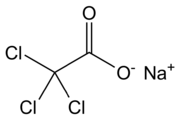Sodium trichloroacetate
Sodium trichloroacetate is a chemical compound with a formula of CCl3CO2Na. It is used to increase sensitivity and precision during transcript mapping.[1]
 | |
| Names | |
|---|---|
| IUPAC name
Sodium trichloroacetate | |
| Identifiers | |
3D model (JSmol) |
|
| ChemSpider | |
| ECHA InfoCard | 100.010.437 |
| EC Number |
|
PubChem CID |
|
| RTECS number |
|
| UNII | |
CompTox Dashboard (EPA) |
|
| |
| |
| Properties | |
| C2Cl3NaO2 | |
| Molar mass | 185.36 g/mol |
| Appearance | White powder |
| Density | ~1.5 g/mL−1 |
| Melting point | 200 °C (392 °F; 473 K) |
| Boiling point | Decomposes |
| 55 g / 100 ml | |
| Solubility | Soluble in methanol and ethanol, slightly soluble in acetone, not soluble in ethers and hydrocarbons |
| Acidity (pKa) | 0.7 (conjugate acid) |
| Hazards | |
| Main hazards | Corrosive |
| GHS pictograms |   |
| GHS Signal word | Warning |
GHS hazard statements |
H335, H400, H410 |
| P261, P271, P273, P304+340, P312, P391, P403+233, P405, P501 | |
| NFPA 704 (fire diamond) | |
| Flash point | Non-flammable |
| Non-flammable | |
| Related compounds | |
Other anions |
Sodium trifluoroacetate |
Other cations |
Trichloroacetic acid |
Related compounds |
Sodium chloroacetate Sodium acetate |
Except where otherwise noted, data are given for materials in their standard state (at 25 °C [77 °F], 100 kPa). | |
| Infobox references | |
Preparation
Sodium trichloroacetate is made by reaction trichloroacetic acid with sodium hydroxide:
Reactions
Basicity
Compared to sodium acetate, The basicity of sodium trichloroacetate is weaker because of the electron-withdrawing nature of the trichloromethyl group. Sodium trifluoroacetate is an even weaker base than that due to higher electronegativity of fluorine atoms. In the presence of strong acids the anion can be protonated:
References
- Murray, M. G. (1986). "Use of sodium trichloroacetate and mung bean nuclease to increase sensitivity and precision during transcript mapping". Analytical Biochemistry. 158 (1): 165–170. doi:10.1016/0003-2697(86)90605-6. ISSN 0003-2697. PMID 2432801.
This article is issued from Wikipedia. The text is licensed under Creative Commons - Attribution - Sharealike. Additional terms may apply for the media files.
